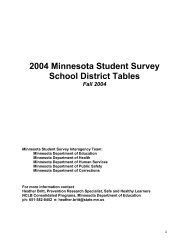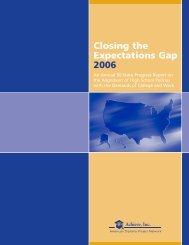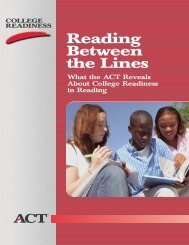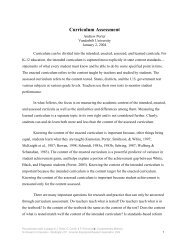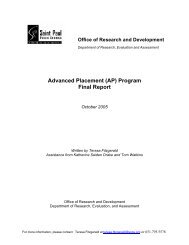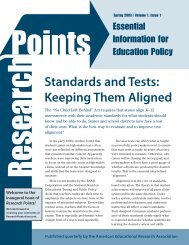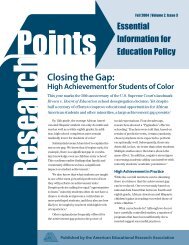Characteristics of Minority Students Who Excel on the SAT ... - ETS
Characteristics of Minority Students Who Excel on the SAT ... - ETS
Characteristics of Minority Students Who Excel on the SAT ... - ETS
You also want an ePaper? Increase the reach of your titles
YUMPU automatically turns print PDFs into web optimized ePapers that Google loves.
Policy Informati<strong>on</strong> Report<str<strong>on</strong>g>Characteristics</str<strong>on</strong>g> <str<strong>on</strong>g>of</str<strong>on</strong>g> <str<strong>on</strong>g>Minority</str<strong>on</strong>g><str<strong>on</strong>g>Students</str<strong>on</strong>g> <str<strong>on</strong>g>Who</str<strong>on</strong>g> <str<strong>on</strong>g>Excel</str<strong>on</strong>g> <strong>on</strong> <strong>the</strong><strong>SAT</strong> and in <strong>the</strong> ClassroomListening.Learning.Leading.
This report was written by:Brent BridgemanCathy WendlerEducati<strong>on</strong>al Testing ServiceThe views expressed in thisreport are those <str<strong>on</strong>g>of</str<strong>on</strong>g> <strong>the</strong> authorsand do not necessarily reflect <strong>the</strong>views <str<strong>on</strong>g>of</str<strong>on</strong>g> <strong>the</strong> <str<strong>on</strong>g>of</str<strong>on</strong>g>ficers and trustees<str<strong>on</strong>g>of</str<strong>on</strong>g> Educati<strong>on</strong>al Testing Service.Additi<strong>on</strong>al copies <str<strong>on</strong>g>of</str<strong>on</strong>g> this reportcan be ordered for $15 (prepaid)from:Policy Informati<strong>on</strong> CenterMail Stop 19-REducati<strong>on</strong>al Testing ServiceRosedale RoadPrincet<strong>on</strong>, NJ 08541-0001(609) 734-5949pic@ets.orgPreface. . . . . . . . . . . . . . . . . . . . . . . . . . . . . . . . . . . . . . . . . . . . . . . . . . . . . . . . . . . . . . . 1Acknowledgments. . . . . . . . . . . . . . . . . . . . . . . . . . . . . . . . . . . . . . . . . . . . . . . . . . . . . . 1Executive Summary. . . . . . . . . . . . . . . . . . . . . . . . . . . . . . . . . . . . . . . . . . . . . . . . . . . . . 2Introducti<strong>on</strong> . . . . . . . . . . . . . . . . . . . . . . . . . . . . . . . . . . . . . . . . . . . . . . . . . . . . . . . . . . . 3High School Courses Taken . . . . . . . . . . . . . . . . . . . . . . . . . . . . . . . . . . . . . . . . . . . . . . 5Activities and H<strong>on</strong>ors . . . . . . . . . . . . . . . . . . . . . . . . . . . . . . . . . . . . . . . . . . . . . . . . . . . 8Academic Success . . . . . . . . . . . . . . . . . . . . . . . . . . . . . . . . . . . . . . . . . . . . . . . . . . . . . 9Parental Educati<strong>on</strong> . . . . . . . . . . . . . . . . . . . . . . . . . . . . . . . . . . . . . . . . . . . . . . . . . . . . 13<strong>SAT</strong> Scores <str<strong>on</strong>g>of</str<strong>on</strong>g> <str<strong>on</strong>g>Students</str<strong>on</strong>g> with Outstanding High School Records. . . . . . . . . . . . . . . . 14<str<strong>on</strong>g>Characteristics</str<strong>on</strong>g> <str<strong>on</strong>g>of</str<strong>on</strong>g> <strong>the</strong> Academic Superstars . . . . . . . . . . . . . . . . . . . . . . . . . . . . . . . . 21C<strong>on</strong>clusi<strong>on</strong>s . . . . . . . . . . . . . . . . . . . . . . . . . . . . . . . . . . . . . . . . . . . . . . . . . . . . . . . . . . 24Copies can be downloaded from:www.ets.org/research/picCopyright © 2005 by Educati<strong>on</strong>alTesting Service. All rightsreserved. Educati<strong>on</strong>al TestingService is an Affirmative Acti<strong>on</strong>/Equal Opportunity Employer.Educati<strong>on</strong>al Testing Service, <strong>ETS</strong>,and <strong>the</strong> <strong>ETS</strong> logo are registeredtrademarks <str<strong>on</strong>g>of</str<strong>on</strong>g> Educati<strong>on</strong>al TestingService.January 2005Policy Evaluati<strong>on</strong> andResearch CenterPolicy Informati<strong>on</strong> CenterEducati<strong>on</strong>al Testing Service
PrefaceAfter a few decades <str<strong>on</strong>g>of</str<strong>on</strong>g> keeping a watchful eye, substantialgaps in <strong>the</strong> average standardized test scores<str<strong>on</strong>g>of</str<strong>on</strong>g> White and some minority group students persist.The average group differences <strong>on</strong> <strong>the</strong> <strong>SAT</strong> are am<strong>on</strong>g<strong>the</strong> most visible examples <str<strong>on</strong>g>of</str<strong>on</strong>g> this pattern. But when wefocus <strong>on</strong>ly <strong>on</strong> mean score differences am<strong>on</strong>g students,we tend to overlook <strong>the</strong> relatively high performingminority students. Many minority students achievehigh <strong>SAT</strong> scores, pursue challenging courses in highschools, take leadership roles in extracurricular activities,and go <strong>on</strong> to succeed in selective colleges. Thesestudents are <strong>the</strong> focus <str<strong>on</strong>g>of</str<strong>on</strong>g> this report.The authors, Brent Bridgeman and Cathy Wendler,identify minority students who achieve relatively high<strong>SAT</strong> scores and examine aspects <str<strong>on</strong>g>of</str<strong>on</strong>g> <strong>the</strong>ir family background,high school course-taking experiences, andleadership activities. Am<strong>on</strong>g <strong>the</strong> questi<strong>on</strong>s <strong>the</strong>y exploreare <strong>the</strong> following three: Do minority students withhigh test scores take <strong>the</strong> same high school courses asWhite students with high test scores? Are <strong>the</strong>y equallysuccessful in <strong>the</strong>se courses? Do minority students whotake demanding courses in high school, and succeedin those courses, perform as well <strong>on</strong> <strong>the</strong> <strong>SAT</strong> as Whitestudents?Bridgeman and Wendler’s findings reassure us that regardless<str<strong>on</strong>g>of</str<strong>on</strong>g> race/ethnicity, students who take rigorouscourses and actively participate in <strong>the</strong>ir high schoolstend to achieve high scores <strong>on</strong> <strong>the</strong> <strong>SAT</strong>. The implicati<strong>on</strong>sthat are clear from Bridgeman and Wendler’sresearch are that meaningful dividends are derivedfrom investments 1) in ensuring that all students areprovided with <strong>the</strong> opportunity to participate in rigoroushigh school curricula, and 2) from student effortsto take full advantage <str<strong>on</strong>g>of</str<strong>on</strong>g> learning opportunities when<strong>the</strong>y are available.Michael T. NettlesVice PresidentPolicy Evaluati<strong>on</strong> andResearch CenterAcknowledgmentsThe authors would like to thank <strong>the</strong> College Board forgiving permissi<strong>on</strong> to use <strong>the</strong> data c<strong>on</strong>tained in this report.They also are grateful for <strong>the</strong> thoughtful reviews<str<strong>on</strong>g>of</str<strong>on</strong>g> <strong>the</strong> draft report provided by Beatrice Bridglall,Columbia University; Henry Braun, Richard Coley,Rosemary Reshetar, and Michael Zieky <str<strong>on</strong>g>of</str<strong>on</strong>g> <strong>ETS</strong>; LloydB<strong>on</strong>d <str<strong>on</strong>g>of</str<strong>on</strong>g> <strong>the</strong> Carnegie Foundati<strong>on</strong> for <strong>the</strong> Advancement<str<strong>on</strong>g>of</str<strong>on</strong>g> Teaching; and Amy Schmidt <str<strong>on</strong>g>of</str<strong>on</strong>g> <strong>the</strong> College Board.Candace Cohen, MaryLee Demeter, and Ca<strong>the</strong>rineTrapani provided statistical analysis.Lynn Jenkins was <strong>the</strong> editor, Joe Kolodey designed<strong>the</strong> cover, and Susan Mills provided desktop publishing.Errors <str<strong>on</strong>g>of</str<strong>on</strong>g> fact or interpretati<strong>on</strong> are those <str<strong>on</strong>g>of</str<strong>on</strong>g> <strong>the</strong>authors.1
Executive SummaryThe familiar term “achievement gap” describes racial/ethnic differences that exist in many academic areas,including average <strong>SAT</strong> ® scores. But if we focus <strong>on</strong>ly <strong>on</strong><strong>the</strong> average gap, we may overlook <strong>the</strong> fact that manyminority students defy stereotypes and receive high<strong>SAT</strong> scores, succeed in rigorous high school courses,and excel in college. In this report, we attempt to betterunderstand <strong>the</strong> characteristics and ambiti<strong>on</strong>s <str<strong>on</strong>g>of</str<strong>on</strong>g><strong>the</strong>se academic superstars from diverse racial/ethnicbackgrounds by examining characteristics <str<strong>on</strong>g>of</str<strong>on</strong>g> <strong>the</strong>sestudents in terms <str<strong>on</strong>g>of</str<strong>on</strong>g> high school courses taken, participati<strong>on</strong>in school activities, leadership experiences,academic success, and parental educati<strong>on</strong>.Using data from <strong>the</strong> nati<strong>on</strong>al cohort <str<strong>on</strong>g>of</str<strong>on</strong>g> studentswho took <strong>the</strong> <strong>SAT</strong> in 2001, some minor differences inacademic accomplishments related to racial/ethnicclassificati<strong>on</strong> were noted for <strong>the</strong>se high-scoring students,but <strong>the</strong>re were more similarities than differences.High-scoring students across all groups tendedto take <strong>the</strong> same types <str<strong>on</strong>g>of</str<strong>on</strong>g> courses and participated inschool activities at about <strong>the</strong> same level. They tendedto be equally successful in <strong>the</strong>se courses, althoughAfrican American students reported slightly lowerGPAs. There were, however, some unexpected differencesseen for lower-scoring students. For example, at<strong>the</strong> middle and low score levels, African American andHispanic students were more likely to take advancedscience classes and Advanced Placement (AP) teststhan <strong>the</strong>ir White and Asian American counterparts.Lower-scoring African American and White studentsreported being more involved in school activities inleadership roles than Asian American and Hispanicstudents. Within each score range, a greater percentage<str<strong>on</strong>g>of</str<strong>on</strong>g> White students indicated having at least <strong>on</strong>eparent with a college degree compared to o<strong>the</strong>r racial/ethnic subgroups.We also looked at <strong>the</strong> percentage <str<strong>on</strong>g>of</str<strong>on</strong>g> students ineach racial/ethnic group who scored over 500 <strong>on</strong> ei<strong>the</strong>r<strong>the</strong> verbal or math secti<strong>on</strong>s <str<strong>on</strong>g>of</str<strong>on</strong>g> <strong>the</strong> <strong>SAT</strong>, and who alsohad outstanding academic records. After accountingfor academic background (using a core set <str<strong>on</strong>g>of</str<strong>on</strong>g> courses,grades, leadership roles, and success in an AdvancedPlacement course) <strong>the</strong> percentage <str<strong>on</strong>g>of</str<strong>on</strong>g> students scoringover 500 <strong>on</strong> <strong>the</strong> <strong>SAT</strong> was essentially identical acrossracial/ethnic groups. Regardless <str<strong>on</strong>g>of</str<strong>on</strong>g> group membership,excelling in rigorous courses goes with high <strong>SAT</strong>scores. It is impossible to tell from <strong>the</strong> current datawhe<strong>the</strong>r succeeding in demanding courses leads tohigh <strong>SAT</strong> scores, or whe<strong>the</strong>r possessing <strong>the</strong> readingand math skills measured by <strong>the</strong> <strong>SAT</strong> causes studentsto do well in <strong>the</strong>se courses, or whe<strong>the</strong>r some outsidefactor leads to success in both <strong>the</strong> school-based andtest-based assessments. It seems likely that all <str<strong>on</strong>g>of</str<strong>on</strong>g> <strong>the</strong>seexplanati<strong>on</strong>s are at least partially correct, so we suggestthat a prudent policy would encourage students totake demanding courses and work <strong>on</strong> <strong>the</strong> reading andmath skills that <strong>the</strong> <strong>SAT</strong> measures; at <strong>the</strong> same time,society should address such school-related factors as<strong>the</strong> quality <str<strong>on</strong>g>of</str<strong>on</strong>g> teaching and class size, and n<strong>on</strong>-schoolfactors such as poor nutriti<strong>on</strong>.Across all subgroups, <strong>the</strong> “academic superstar”students (those who scored 1300 or higher <strong>on</strong> <strong>the</strong> <strong>SAT</strong>and had very high course grades in demanding courses)generally reported having at least <strong>on</strong>e parent with acollege degree, providing support for <strong>the</strong> hypo<strong>the</strong>sizedbenefit <str<strong>on</strong>g>of</str<strong>on</strong>g> <strong>the</strong> academic envir<strong>on</strong>ment at home. Never<strong>the</strong>less,<strong>the</strong>re were also many highly successful studentsfrom families without a college-educated parent.Choices <str<strong>on</strong>g>of</str<strong>on</strong>g> college major seemed more related toacademic background than to racial/ethnic group.There were <strong>on</strong>ly a few college major choices that wererelated to racial/ethnic group membership (e.g., AsianAmerican students were less likely to select majors in<strong>the</strong> social sciences). Gender differences, <strong>on</strong> <strong>the</strong> o<strong>the</strong>rhand, were substantial, with men much more likely toselect majors in engineering and women more likely toselect majors in <strong>the</strong> biological sciences. Perhaps mostsignificant for nurturing <strong>the</strong> next generati<strong>on</strong> <str<strong>on</strong>g>of</str<strong>on</strong>g> outstandingstudents, <strong>the</strong> current generati<strong>on</strong> <str<strong>on</strong>g>of</str<strong>on</strong>g> “academicsuperstars,” regardless <str<strong>on</strong>g>of</str<strong>on</strong>g> racial/ethnic or gendergroup, expressed virtually no interest in majoring ineducati<strong>on</strong>.2
Introducti<strong>on</strong>On average, African American and Hispanic studentsscore much lower <strong>on</strong> <strong>the</strong> <strong>SAT</strong> ® I: Reas<strong>on</strong>ing Test(<strong>SAT</strong>) than do Asian American and White students.On average, African American and Hispanic studentstake fewer high school courses that are “associatedwith higher <strong>SAT</strong> scores” and have lower high schoolgrades. 1 But, <strong>the</strong> proverbial statistician who drownedin <strong>the</strong> lake that was, <strong>on</strong> average, <strong>on</strong>ly three feet deepshould remind us that <strong>the</strong> average can hide meaningfulvariati<strong>on</strong>. In particular, <strong>the</strong>re are many AfricanAmerican and Hispanic students who do have high<strong>SAT</strong> scores, and who have succeeded in rigorous highschool courses. Our purpose here is to better understand<strong>the</strong> characteristics and ambiti<strong>on</strong>s <str<strong>on</strong>g>of</str<strong>on</strong>g> <strong>the</strong>seexcepti<strong>on</strong>al students. Do minority students with hightest scores take <strong>the</strong> same high school courses as Whitestudents with high test scores? Are <strong>the</strong>y equally successfulin <strong>the</strong>se courses? Do minority students whotook demanding courses in high school, and succeededin <strong>the</strong>m, do as well <strong>on</strong> <strong>the</strong> <strong>SAT</strong> as White students? Dominority students who excelled in high school andwho had very high <strong>SAT</strong> scores have <strong>the</strong> same ambiti<strong>on</strong>sin terms <str<strong>on</strong>g>of</str<strong>on</strong>g> college major as White students withsimilar academic credentials?Knowledge <str<strong>on</strong>g>of</str<strong>on</strong>g> similarities and differences am<strong>on</strong>gstudents from various subgroups becomes even moreimportant in light <str<strong>on</strong>g>of</str<strong>on</strong>g> <strong>the</strong> changes to <strong>the</strong> <strong>SAT</strong> that willbe introduced in Spring 2005. Some test c<strong>on</strong>tent willbe based <strong>on</strong> higher-level high school courses thanbefore. Although taking advanced courses (e.g., threeyears <str<strong>on</strong>g>of</str<strong>on</strong>g> college-preparatory math) provides usefulpractice for <strong>the</strong> current <strong>SAT</strong>, such courses also willprovide essential c<strong>on</strong>tent knowledge for <strong>the</strong> new <strong>SAT</strong>.Understanding differences in classroom experienceswill <strong>the</strong>n become even more important in interpretingdifferences in group scores. Recent evidence suggeststhat <strong>on</strong>ly 32 percent <str<strong>on</strong>g>of</str<strong>on</strong>g> <strong>the</strong> students in <strong>the</strong> UnitedStates leave high school with <strong>the</strong> literacy skills andcourses taken that are required for success in four-year colleges. Am<strong>on</strong>g African American and Hispanicstudents <strong>the</strong> percentages are even smaller (20 percentand 16 percent respectively). 2Data SourceData for <strong>the</strong> current analyses came from a database <str<strong>on</strong>g>of</str<strong>on</strong>g>students who were high school seniors in 2001, whohad taken <strong>the</strong> <strong>SAT</strong>, and who had completed <strong>the</strong> <strong>SAT</strong>Questi<strong>on</strong>naire that students are asked to completewhen <strong>the</strong>y register to take <strong>the</strong> <strong>SAT</strong>. 3 The <strong>SAT</strong> measuresverbal and ma<strong>the</strong>matical reas<strong>on</strong>ing skills thatdevelop over a l<strong>on</strong>g period <str<strong>on</strong>g>of</str<strong>on</strong>g> time, both inside andoutside <str<strong>on</strong>g>of</str<strong>on</strong>g> school. The <strong>SAT</strong> Questi<strong>on</strong>naire resp<strong>on</strong>sesc<strong>on</strong>sist <str<strong>on</strong>g>of</str<strong>on</strong>g> self-reported informati<strong>on</strong> <strong>on</strong> high schoolcourses, extracurricular activities, family characteristics(e.g., parental educati<strong>on</strong>), projected college major,and o<strong>the</strong>r demographic informati<strong>on</strong>. Student recordswere from a matched database <str<strong>on</strong>g>of</str<strong>on</strong>g> students who hadtaken <strong>the</strong> <strong>SAT</strong> and o<strong>the</strong>r College Board Tests, includingtests in <strong>the</strong> Advanced Placement (AP) program. AP<str<strong>on</strong>g>of</str<strong>on</strong>g>fers college-level courses for high school students,and provides a way for colleges to grant college creditfor students who do well <strong>on</strong> <strong>the</strong> end-<str<strong>on</strong>g>of</str<strong>on</strong>g>-course AP tests.Thus, doing well in AP courses provides evidence that<strong>the</strong> student not <strong>on</strong>ly has <strong>the</strong> potential to succeed incollege-level work, but in fact has already d<strong>on</strong>e so.Although our primary focus is <strong>on</strong> high-scoring andhigh-achieving students, we include two lower-scoringgroups for comparis<strong>on</strong>. Specifically, students in threescore ranges were identified:• top 10 percent (high range): students with a total<strong>SAT</strong> Verbal + Math score at or above 1300;• middle 10 percent (middle range): students with atotal Verbal + Math score between 1000 and 1050;and• low 10 percent (low range): students with a totalVerbal + Math score below 760. 41 College Board press release when “College Bound Seniors” report announced, August 2003.2 J. P. Greene & G. Forster, Public High School Graduati<strong>on</strong> and College Readiness Rates in <strong>the</strong> United States. New York: Center for Civic Innovati<strong>on</strong>at <strong>the</strong> Manhattan Institute, 2003.3 This sample <str<strong>on</strong>g>of</str<strong>on</strong>g> over a milli<strong>on</strong> college-bound students should be adequate for our purposes, but it should be understood that students whodid not take <strong>the</strong> <strong>SAT</strong> are excluded. They may have taken <strong>the</strong> ACT or chosen not to take any standardized test. Also excluded are <strong>the</strong>16 percent <str<strong>on</strong>g>of</str<strong>on</strong>g> <strong>the</strong> examinees who chose not to answer <strong>the</strong> race/ethnic group questi<strong>on</strong> <strong>on</strong> <strong>the</strong> <strong>SAT</strong> Questi<strong>on</strong>naire.4 If a student took <strong>the</strong> <strong>SAT</strong> more than <strong>on</strong>ce, we took <strong>the</strong> highest combined score from a single administrati<strong>on</strong>.3
Table 1:Number <str<strong>on</strong>g>of</str<strong>on</strong>g> <str<strong>on</strong>g>Students</str<strong>on</strong>g> in Each Selected <strong>SAT</strong> Score Range<strong>SAT</strong> (V + M) Score RangeGroupHigh(>1300)Middle(1000-1050)Low(
High School Courses TakenTaking a rigorous course load in high school has beenshown to be <strong>on</strong>e <str<strong>on</strong>g>of</str<strong>on</strong>g> <strong>the</strong> best indicators <str<strong>on</strong>g>of</str<strong>on</strong>g> succeedingin college through attainment <str<strong>on</strong>g>of</str<strong>on</strong>g> a bachelor’s degree. 5And it has been observed that African American andHispanic students, <strong>on</strong> average, are less likely to takesuch challenging courses as physics and precalculus orcalculus. 6 What is less clear is to what extent <strong>the</strong>se differencesin course-taking patterns differ by racial/ethnicgroup am<strong>on</strong>g students with high (and middle andlow) <strong>SAT</strong> scores. That is, are minority students moreor less likely to take demanding courses compared toWhite students with similar reading and ma<strong>the</strong>maticalskills? The majority <str<strong>on</strong>g>of</str<strong>on</strong>g> college-bound students fromall subgroups have taken 4 years <str<strong>on</strong>g>of</str<strong>on</strong>g> English and 3 to 4years <str<strong>on</strong>g>of</str<strong>on</strong>g> ma<strong>the</strong>matics, but <strong>the</strong>re may be differences in<strong>the</strong> taking <str<strong>on</strong>g>of</str<strong>on</strong>g> o<strong>the</strong>r college preparatory classes, such asscience and foreign languages. Therefore, we specificallyinvestigated differences in course-taking patternsfor <strong>the</strong>se courses.Science courses. Figures 1 through 3 show <strong>the</strong>percentage <str<strong>on</strong>g>of</str<strong>on</strong>g> students, by racial/ethnic group and <strong>SAT</strong>score level, who reported taking courses in chemistry,physics, or two years <str<strong>on</strong>g>of</str<strong>on</strong>g> biology. (Because nearly allstudents in our college-bound sample had <strong>on</strong>e year <str<strong>on</strong>g>of</str<strong>on</strong>g>biology, we include <strong>on</strong>ly <strong>the</strong> graph for two years.)Figure 1Percentage <str<strong>on</strong>g>of</str<strong>on</strong>g> <strong>SAT</strong> Test Takers Taking at Least OneYear <str<strong>on</strong>g>of</str<strong>on</strong>g> Chemistry, by Score Level and Racial/Ethnic GroupFigure 2Percentage <str<strong>on</strong>g>of</str<strong>on</strong>g> <strong>SAT</strong> Test Takers Taking at Least OneYear <str<strong>on</strong>g>of</str<strong>on</strong>g> Physics, by Score Level and Racial/EthnicGroupHigh ScorersWhiteAsianHispanicAfrican AmericanMiddle ScorersWhiteAsianHispanicAfrican AmericanLow ScorersWhiteAsianHispanicAfrican American516360589291929182848486High ScorersWhiteAsianHispanicAfrican AmericanMiddle ScorersWhiteAsianHispanicAfrican AmericanLow ScorersWhiteAsianHispanicAfrican American14192320395447477373727602040 60Percentage8010002040 60Percentage801005 C. Adelman, Answers in <strong>the</strong> Tool Box: Academic Intensity, Attendance Patterns, and Bachelor’s Degree Attainment. Washingt<strong>on</strong>, DC: U. S.Department <str<strong>on</strong>g>of</str<strong>on</strong>g> Educati<strong>on</strong>, 1999.6 College Board, College-Bound Seniors, 2003. http://www.collegeboard.com/press/article/0,3183,26858,00.html. See “Tables and RelatedItems,” Graph 8.5
Overall, African American and Hispanic studentsare less likely than White students to take challengingcourses. Within each score level, however, <strong>the</strong>y are aslikely or more likely to take such courses. This is anexample <str<strong>on</strong>g>of</str<strong>on</strong>g> Simps<strong>on</strong>’s paradox. 7 The explanati<strong>on</strong> <str<strong>on</strong>g>of</str<strong>on</strong>g><strong>the</strong> paradox is that <strong>the</strong> African American and Hispanicstudents are relatively more numerous at <strong>the</strong> lowerscore levels, and fewer advanced courses are takenat <strong>the</strong>se levels. The problem is not that high-scoringminorities do not take challenging courses, but ra<strong>the</strong>rthat <strong>the</strong>re are too few high-scoring minority students.Although we may have a clearer idea <str<strong>on</strong>g>of</str<strong>on</strong>g> <strong>the</strong> problem,<strong>the</strong> soluti<strong>on</strong> remains elusive, especially given <strong>the</strong>difficulty in determining what is cause and what is effect.It is possible that high-scoring students choose totake hard courses, and are successful in those courses,because possessing <strong>the</strong> verbal and quantitative reas<strong>on</strong>ingskills measured by <strong>the</strong> <strong>SAT</strong> makes succeeding insuch courses easier. It is equally reas<strong>on</strong>able to inferthat <strong>the</strong>y succeeded <strong>on</strong> <strong>the</strong> <strong>SAT</strong> because taking challengingcourses provided better preparati<strong>on</strong> to do well<strong>on</strong> <strong>the</strong> test, or that some critical outside factor (e.g.,parental involvement) encouraged both academicsuccess and success <strong>on</strong> <strong>the</strong> <strong>SAT</strong>. If we could close <strong>the</strong>test score gap between minority and White students,<strong>the</strong> gap in course taking might also close. But it mightbe difficult or impossible to close <strong>the</strong> test score gap asFigure 3Percentage <str<strong>on</strong>g>of</str<strong>on</strong>g> <strong>SAT</strong> Test Takers Taking at Least TwoYears <str<strong>on</strong>g>of</str<strong>on</strong>g> Biology, by Score Level and Racial/EthnicGroupFigure 4Percentage <str<strong>on</strong>g>of</str<strong>on</strong>g> <strong>SAT</strong> Test Takers Taking at LeastThree Years <str<strong>on</strong>g>of</str<strong>on</strong>g> a Foreign Language, by Score Leveland Racial/Ethnic GroupHigh ScorersWhiteAsianHispanicAfrican AmericanMiddle ScorersWhiteAsianHispanicAfrican AmericanLow ScorersWhiteAsianHispanicAfrican American11121098791222312524High ScorersWhiteAsianHispanicAfrican AmericanMiddle ScorersWhiteAsianHispanicAfrican AmericanLow ScorersWhiteAsianHispanicAfrican American21203135515957527984818002040 60Percentage8010002040 60Percentage801007 For a more complete descripti<strong>on</strong> <str<strong>on</strong>g>of</str<strong>on</strong>g> this paradox, see H. Wainer, “<str<strong>on</strong>g>Minority</str<strong>on</strong>g> C<strong>on</strong>tributi<strong>on</strong>s to <strong>the</strong> <strong>SAT</strong> Score Turnaround: An Example <str<strong>on</strong>g>of</str<strong>on</strong>g>Simps<strong>on</strong>’s Paradox,” Journal <str<strong>on</strong>g>of</str<strong>on</strong>g> Educati<strong>on</strong>al Statistics, 11, 1986: 229-2446
l<strong>on</strong>g as students in <strong>the</strong> lower-scoring groups are nottaking challenging courses.Foreign languages. Figure 4 shows <strong>the</strong> percentagein each group that had taken at least three years <str<strong>on</strong>g>of</str<strong>on</strong>g> aforeign language. Once again, within score levels, <strong>the</strong>percentages for African American and White studentsare virtually identical, and percentages are slightlyhigher for Asian American and Hispanic students.The relatively high percentages for Asian Americanand Hispanic students in <strong>the</strong> lowest category may berelated to taking “foreign” languages that are actually<strong>the</strong>ir native t<strong>on</strong>gues.Advanced Placement courses. The above resultswere based <strong>on</strong> self-reports. Although we have no hardevidence that students in different racial/ethnic groupsare differentially inflating <strong>the</strong>ir academic records, <strong>the</strong>possibility exists. 8 Informati<strong>on</strong> <strong>on</strong> AP course taking(or more accurately, AP test taking) was obtained from<str<strong>on</strong>g>of</str<strong>on</strong>g>ficial records, and so could not c<strong>on</strong>tain any reportingbias. Never<strong>the</strong>less, Figure 5 shows <strong>the</strong> now-familiarpattern. At <strong>the</strong> highest score level, <strong>the</strong>re are essentiallyno differences across racial/ethnic groups in <strong>the</strong> percentage<str<strong>on</strong>g>of</str<strong>on</strong>g> students who took at least <strong>on</strong>e AP test. At<strong>the</strong> middle and low score levels, African American andHispanic students are actually more likely than Whitestudents to take AP tests. 9 Figure 6 shows <strong>the</strong> patternrepeated for students who took two or more AP tests.Figure 5Percentage <str<strong>on</strong>g>of</str<strong>on</strong>g> <strong>SAT</strong> Test Takers Taking at Least OneAP Examinati<strong>on</strong>, by Score Level and Racial/EthnicGroupFigure 6Percentage <str<strong>on</strong>g>of</str<strong>on</strong>g> <strong>SAT</strong> Test Takers Taking at LeastTwo AP Examinati<strong>on</strong>s, by Score Level and Racial/Ethnic GroupHigh ScorersWhiteAsianHispanicAfrican AmericanMiddle ScorersWhiteAsianHispanicAfrican AmericanLow ScorersWhiteAsianHispanicAfrican American193736434256544985908883High ScorersWhiteAsianHispanicAfrican AmericanMiddle ScorersWhiteAsianHispanicAfrican AmericanLow ScorersWhiteAsianHispanicAfrican American7183431271715157583787102040 60Percentage8010002040 60Percentage801008 Fetters, Stowe, and Owings (Quality <str<strong>on</strong>g>of</str<strong>on</strong>g> Resp<strong>on</strong>ses <str<strong>on</strong>g>of</str<strong>on</strong>g> High School <str<strong>on</strong>g>Students</str<strong>on</strong>g> to Questi<strong>on</strong>naire Items. Washingt<strong>on</strong>, DC: Nati<strong>on</strong>al Center forEducati<strong>on</strong> Statistics, 1984) noted a tendency for African American and Hispanic high school students to inflate <strong>the</strong>ir reports <str<strong>on</strong>g>of</str<strong>on</strong>g> coursestaken more than White students. However, in <strong>the</strong> more select group <str<strong>on</strong>g>of</str<strong>on</strong>g> college-bound students who take <strong>the</strong> <strong>SAT</strong> and resp<strong>on</strong>d to <strong>the</strong> <strong>SAT</strong>Questi<strong>on</strong>naire, such inflati<strong>on</strong> may be less severe. Although we have no direct evidence <str<strong>on</strong>g>of</str<strong>on</strong>g> accuracy <str<strong>on</strong>g>of</str<strong>on</strong>g> reporting courses taken, Freeberg(Analysis <str<strong>on</strong>g>of</str<strong>on</strong>g> <strong>the</strong> Revised Student Descriptive Questi<strong>on</strong>naire: Accuracy <str<strong>on</strong>g>of</str<strong>on</strong>g> Student-Reported Informati<strong>on</strong>. New York: College EntranceExaminati<strong>on</strong> Board, 1988) noted that <strong>on</strong> <strong>the</strong> <strong>SAT</strong> Questi<strong>on</strong>naire, African American students were somewhat less accurate in reportingclass rank, but that <strong>the</strong>y were about as likely to under-report as to over-report; White students were slightly more likely to over-report.9 Overall, a smaller proporti<strong>on</strong> <str<strong>on</strong>g>of</str<strong>on</strong>g> African American students than White or Hispanic students take AP examinati<strong>on</strong>s (K. H<str<strong>on</strong>g>of</str<strong>on</strong>g>fman, C. Llagas,& T.D. Snyder, Status and Trends in <strong>the</strong> Educati<strong>on</strong> <str<strong>on</strong>g>of</str<strong>on</strong>g> Blacks. Washingt<strong>on</strong>, DC: Nati<strong>on</strong>al Center for Educati<strong>on</strong> Statistics, 2003.) Thus, <strong>the</strong>observed pattern is ano<strong>the</strong>r example <str<strong>on</strong>g>of</str<strong>on</strong>g> Simps<strong>on</strong>’s paradox in which <strong>the</strong> within-category results differ from <strong>the</strong> overall result.7
Activities and H<strong>on</strong>orsThe high school experience is more than just academicpreparati<strong>on</strong>. It also presents an opportunity forstudents to show <strong>the</strong>ir leadership potential throughparticipati<strong>on</strong> in extra-curricular activities. Theseactivities can be in <strong>the</strong> form <str<strong>on</strong>g>of</str<strong>on</strong>g> a school club, sportteam, academic team, etc. Mere membership in anorganizati<strong>on</strong> may not represent any true commitmentor accomplishment, but holding a leadership positi<strong>on</strong>or earning an h<strong>on</strong>or (such as a journalism prize or avarsity letter) shows a greater degree <str<strong>on</strong>g>of</str<strong>on</strong>g> involvement.Figure 7 presents a comparis<strong>on</strong> <str<strong>on</strong>g>of</str<strong>on</strong>g> high-, middle-,and low-scoring students regarding leadership involvementin at least <strong>on</strong>e extra-curricular activity; Figure 8 isfor two or more activities. In both figures, racial/ethnicFigure 7Percentage <str<strong>on</strong>g>of</str<strong>on</strong>g> <strong>SAT</strong> Test Takers <str<strong>on</strong>g>Who</str<strong>on</strong>g> Reported Beingan Officer or Receiving an Award for at LeastOne Activity, by Score Level and Racial/EthnicGroupdifferences are very small at <strong>the</strong> highest score level, asall racial/ethnic groups show a high degree <str<strong>on</strong>g>of</str<strong>on</strong>g> leadershipinvolvement in <strong>the</strong>ir schools. Although high <strong>SAT</strong>scores would not seem to be a prerequisite for suchinvolvement, note that <strong>the</strong>re was c<strong>on</strong>siderably lessinvolvement at <strong>the</strong> lower score levels. This may reflectan overall lower level <str<strong>on</strong>g>of</str<strong>on</strong>g> engagement with anythingrelated to school am<strong>on</strong>g <strong>the</strong>se low-scoring students.Racial/ethnic differences were essentially absent at <strong>the</strong>highest score levels, but at <strong>the</strong> middle and low levels,African American and White students appeared to besomewhat more involved than Asian American andHispanic students.Figure 8Percentage <str<strong>on</strong>g>of</str<strong>on</strong>g> <strong>SAT</strong> Test Takers <str<strong>on</strong>g>Who</str<strong>on</strong>g> Reported Beingan Officer or Receiving an Award for Two orMore Activities, by Score Level and Racial/EthnicGroupHigh ScorersWhiteAsianHispanicAfrican AmericanMiddle ScorersWhiteAsianHispanicAfrican AmericanLow ScorersWhiteAsianHispanicAfrican American523842507163657285838384High ScorersWhiteAsianHispanicAfrican AmericanMiddle ScorersWhiteAsianHispanicAfrican AmericanLow ScorersWhiteAsianHispanicAfrican American32222329524446537169697002040 60Percentage8010002040 60Percentage801008
Academic SuccessAs indicated in Figure 9, <strong>the</strong>re is a str<strong>on</strong>g relati<strong>on</strong>shipbetween <strong>SAT</strong> score level and a high level <str<strong>on</strong>g>of</str<strong>on</strong>g> academicsuccess in high school, defined as an “A” (includingA+). African American students scoring in <strong>the</strong> highrange report a GPA <str<strong>on</strong>g>of</str<strong>on</strong>g> “A” or above less frequently thando <strong>the</strong>ir Asian American, White, and Hispanic counterparts;in <strong>the</strong> middle and low score ranges, however,this discrepancy disappears. A more interesting patternemerges when both gender and racial/ethnic classificati<strong>on</strong>sare c<strong>on</strong>sidered simultaneously. As indicatedin Figure 10, and c<strong>on</strong>sistent with previous research, 10across racial/ethnic groups, and across <strong>SAT</strong> scorelevels, women are more likely to have high GPAs thanmen. At <strong>the</strong> highest <strong>SAT</strong> level, African American womendo not perform quite as well as women in <strong>the</strong> o<strong>the</strong>rracial/ethnic groups, but <strong>the</strong>y still perform as well as<strong>the</strong> men in every <strong>on</strong>e <str<strong>on</strong>g>of</str<strong>on</strong>g> <strong>the</strong> racial/ethnic groups.Figures 11 through 15 show essentially <strong>the</strong> samepattern for “A” grades in English, math, natural science,social science/history, and art/music. Given <strong>the</strong>kinds <str<strong>on</strong>g>of</str<strong>on</strong>g> skills assessed by <strong>the</strong> <strong>SAT</strong>, <strong>the</strong> closer relati<strong>on</strong>ship<str<strong>on</strong>g>of</str<strong>on</strong>g> <strong>SAT</strong> scores to grades in academic courses thanto grades in art and music is to be expected.Figure 9Percentage <str<strong>on</strong>g>of</str<strong>on</strong>g> <strong>SAT</strong> Test Takers <str<strong>on</strong>g>Who</str<strong>on</strong>g> Reporteda GPA <str<strong>on</strong>g>of</str<strong>on</strong>g> “A,” by Score Level and Racial/EthnicGroupHigh ScorersMiddle ScorersLow ScorersWhiteAsianHispanicAfrican AmericanWhiteAsianHispanicAfrican AmericanWhiteAsianHispanicAfrican American0243310141514204659575540 60Percentage8010010 See, for example, W.W. Willingham & N. S. Cole, Gender and Fair Assessment. Hillsdale, NJ: Erlbaum, 1997.9
Figure 10Percentage <str<strong>on</strong>g>of</str<strong>on</strong>g> <strong>SAT</strong> Test Takers <str<strong>on</strong>g>Who</str<strong>on</strong>g> Reported aGPA <str<strong>on</strong>g>of</str<strong>on</strong>g> “A,” by Score Level, Gender, and Racial/Ethnic GroupFigure 11Percentage <str<strong>on</strong>g>of</str<strong>on</strong>g> <strong>SAT</strong> Test Takers <str<strong>on</strong>g>Who</str<strong>on</strong>g> Reported aGPA <str<strong>on</strong>g>of</str<strong>on</strong>g> “A” in English, by Score Level, Gender, andRacial/Ethnic GroupHigh ScorersWhite MalesAsian MalesHispanic MalesAfrican American Males43555654High ScorersWhite MalesAsian MalesHispanic MalesAfrican American Males66656357White FemalesAsian FemalesHispanic FemalesAfrican American FemalesMiddle ScorersWhite MalesAsian MalesHispanic MalesAfrican American Males1115151069666455White FemalesAsian FemalesHispanic FemalesAfrican American FemalesMiddle ScorersWhite MalesAsian MalesHispanic MalesAfrican American Males2326261984828074White FemalesAsian FemalesHispanic FemalesAfrican American FemalesLow ScorersWhite MalesAsian MalesHispanic MalesAfrican American Males243221252422White FemalesAsian FemalesHispanic FemalesAfrican American FemalesLow ScorersWhite MalesAsian MalesHispanic MalesAfrican American Males61110644464238White FemalesAsian FemalesHispanic FemalesAfrican American Females3854White FemalesAsian FemalesHispanic FemalesAfrican American Females1220161302040 60Percentage8010002040 60Percentage8010010
Figure 12Percentage <str<strong>on</strong>g>of</str<strong>on</strong>g> <strong>SAT</strong> Test Takers <str<strong>on</strong>g>Who</str<strong>on</strong>g> Reported aGPA <str<strong>on</strong>g>of</str<strong>on</strong>g> “A” in Ma<strong>the</strong>matics, by Score Level,Gender, and Racial/Ethnic GroupFigure 13Percentage <str<strong>on</strong>g>of</str<strong>on</strong>g> <strong>SAT</strong> Test Takers <str<strong>on</strong>g>Who</str<strong>on</strong>g> Reported aGPA <str<strong>on</strong>g>of</str<strong>on</strong>g> “A” in Natural Science, by Score Level,Gender, and Racial/Ethnic GroupHigh ScorersWhite MalesAsian MalesHispanic MalesAfrican American Males65606975High ScorersWhite MalesAsian MalesHispanic MalesAfrican American Males59727469White FemalesAsian FemalesHispanic FemalesAfrican American FemalesMiddle ScorersWhite MalesAsian MalesHispanic MalesAfrican American Males2435282167637477White FemalesAsian FemalesHispanic FemalesAfrican American FemalesMiddle ScorersWhite MalesAsian MalesHispanic MalesAfrican American Males2631282363797774White FemalesAsian FemalesHispanic FemalesAfrican American FemalesLow ScorersWhite MalesAsian MalesHispanic MalesAfrican American Males6149630373026White FemalesAsian FemalesHispanic FemalesAfrican American FemalesLow ScorersWhite MalesAsian MalesHispanic MalesAfrican American Males81110735393431White FemalesAsian FemalesHispanic FemalesAfrican American Females71587White FemalesAsian FemalesHispanic FemalesAfrican American Females1016111002040 60Percentage8010002040 60Percentage8010011
Figure 14Percentage <str<strong>on</strong>g>of</str<strong>on</strong>g> <strong>SAT</strong> Test Takers <str<strong>on</strong>g>Who</str<strong>on</strong>g> Reported aGPA <str<strong>on</strong>g>of</str<strong>on</strong>g> “A” in Social Sciences/History, by ScoreLevel, Gender, and Racial/Ethnic GroupFigure 15Percentage <str<strong>on</strong>g>of</str<strong>on</strong>g> <strong>SAT</strong> Test Takers <str<strong>on</strong>g>Who</str<strong>on</strong>g> Reported aGPA <str<strong>on</strong>g>of</str<strong>on</strong>g> “A” in Art and Music, by Score Level,Gender, and Racial/Ethnic GroupHigh ScorersWhite MalesAsian MalesHispanic MalesAfrican American Males62727572High ScorersWhite MalesAsian MalesHispanic MalesAfrican American Males73747367White FemalesAsian FemalesHispanic FemalesAfrican American FemalesMiddle ScorersWhite MalesAsian MalesHispanic MalesAfrican American Males3840383270848281White FemalesAsian FemalesHispanic FemalesAfrican American FemalesMiddle ScorersWhite MalesAsian MalesHispanic MalesAfrican American Males5457565287858481White FemalesAsian FemalesHispanic FemalesAfrican American FemalesLow ScorersWhite MalesAsian MalesHispanic MalesAfrican American Males1218161147494643White FemalesAsian FemalesHispanic FemalesAfrican American FemalesLow ScorersWhite MalesAsian MalesHispanic MalesAfrican American Males3239383374737066White FemalesAsian FemalesHispanic FemalesAfrican American Females142317White FemalesAsian FemalesHispanic FemalesAfrican American Females5253454202040 60Percentage8010002040 60Percentage8010012
Parental Educati<strong>on</strong>Figure 16 reflects <strong>the</strong> familiar relati<strong>on</strong>ship between<strong>SAT</strong> scores and parental educati<strong>on</strong>, with higher scoresassociated with better-educated parents. Within eachscore level, White students were more likely thanthose in o<strong>the</strong>r racial/ethnic groups to have at least <strong>on</strong>eparent with a college degree. Never<strong>the</strong>less, a collegeeducatedparent is not a necessary c<strong>on</strong>diti<strong>on</strong> for high<strong>SAT</strong> scores, as over a quarter <str<strong>on</strong>g>of</str<strong>on</strong>g> high-scoring AfricanAmerican and Hispanic students indicate that nei<strong>the</strong>rparent has a college degree.Figure 16Percentage <str<strong>on</strong>g>of</str<strong>on</strong>g> <strong>SAT</strong> Test Takers Having a Parentwith a Bachelor’s Degree or Higher, by Score Leveland Racial/Ethnic GroupHigh ScorersMiddle ScorersLow ScorersWhiteAsianHispanicAfrican AmericanWhiteAsianHispanicAfrican AmericanWhiteAsianHispanicAfrican American14222926344745527173778202040 60Percentage8010013
<strong>SAT</strong> Scores <str<strong>on</strong>g>of</str<strong>on</strong>g> <str<strong>on</strong>g>Students</str<strong>on</strong>g> with Outstanding High School RecordsIn <strong>the</strong> previous secti<strong>on</strong>s, we examined course takingand o<strong>the</strong>r characteristics <str<strong>on</strong>g>of</str<strong>on</strong>g> minority and Whitestudents with high <strong>SAT</strong> scores. In this secti<strong>on</strong>, we turn<strong>the</strong> questi<strong>on</strong> around to look at <strong>SAT</strong> scores <str<strong>on</strong>g>of</str<strong>on</strong>g> studentswith outstanding academic records. We use <strong>the</strong> samesample <str<strong>on</strong>g>of</str<strong>on</strong>g> students from <strong>the</strong> group <str<strong>on</strong>g>of</str<strong>on</strong>g> 2001 collegeboundseniors.We define an outstanding record as taking andsucceeding in demanding courses, being an <str<strong>on</strong>g>of</str<strong>on</strong>g>ficer orreceiving an award in a school activity, and succeedingin Advanced Placement courses. We start with <strong>the</strong>nearly <strong>on</strong>e milli<strong>on</strong> college-bound seniors from fourracial/ethnic groups (Asian American, African American,Hispanic, and White). Ra<strong>the</strong>r than focusing <strong>on</strong>mean <strong>SAT</strong> performance, which hides <strong>the</strong> number <str<strong>on</strong>g>of</str<strong>on</strong>g>students performing below <strong>the</strong> mean, we focus <strong>on</strong> <strong>the</strong>percentage <str<strong>on</strong>g>of</str<strong>on</strong>g> <strong>the</strong> students in each group who score510 or higher. This number is close to <strong>the</strong> nati<strong>on</strong>al <strong>SAT</strong>means <str<strong>on</strong>g>of</str<strong>on</strong>g> 506 in verbal and 514 in math for 2001. 11More importantly, scoring at or above 510 places astudent in <strong>the</strong> mid-range <str<strong>on</strong>g>of</str<strong>on</strong>g> <strong>SAT</strong> scores for incomingfreshmen at hundreds <str<strong>on</strong>g>of</str<strong>on</strong>g> colleges and universities,including many major state universities. 12Figure 17 presents <strong>the</strong> percentage <str<strong>on</strong>g>of</str<strong>on</strong>g> students ineach group scoring over 500 <strong>on</strong> <strong>the</strong> <strong>SAT</strong>-Verbal (notethat “over 500” means 510 or higher because <strong>the</strong> lastdigit <str<strong>on</strong>g>of</str<strong>on</strong>g> <strong>SAT</strong> scores is always 0). This reflects <strong>the</strong> familiarbroad gap am<strong>on</strong>g racial/ethnic groups. Well overhalf <str<strong>on</strong>g>of</str<strong>on</strong>g> <strong>the</strong> White students have <strong>SAT</strong>-Verbal scores over500, while fewer than 25 percent <str<strong>on</strong>g>of</str<strong>on</strong>g> African Americanstudents score in this range.Racial/ethnic groups differ in terms <str<strong>on</strong>g>of</str<strong>on</strong>g> averageacademic preparati<strong>on</strong> in high school, and no statisticaladjustments can make <strong>the</strong>m equivalent. But wecan look at score differences am<strong>on</strong>g examinees whohave had more similar academic backgrounds. First,we c<strong>on</strong>sider <strong>on</strong>ly students who have taken a demandingset <str<strong>on</strong>g>of</str<strong>on</strong>g> courses, which we define as including atleast two years <str<strong>on</strong>g>of</str<strong>on</strong>g> <strong>on</strong>e foreign language, an advancedFigure 17Percentage <str<strong>on</strong>g>of</str<strong>on</strong>g> <strong>SAT</strong> Test Takers with Verbal ScoresOver 500, by Racial/Ethnic GroupWhiteAsianHispanicAfrican American020213040 60Percentagemath course (trig<strong>on</strong>ometry or precalculus), and physics.Opportunity to learn is not an issue here becausevirtually all high schools <str<strong>on</strong>g>of</str<strong>on</strong>g>fer <strong>the</strong>se courses, althoughwe recognize that <strong>the</strong> quality <str<strong>on</strong>g>of</str<strong>on</strong>g> <strong>the</strong>se courses can varysubstantially am<strong>on</strong>g different high schools.The first set <str<strong>on</strong>g>of</str<strong>on</strong>g> bars in Figure 18 repeats Figure 17for comparis<strong>on</strong>, and <strong>the</strong> next set <str<strong>on</strong>g>of</str<strong>on</strong>g> bars reflects <strong>on</strong>lythose students who took demanding courses. Over 40percent <str<strong>on</strong>g>of</str<strong>on</strong>g> <strong>the</strong> African American students and nearly50 percent <str<strong>on</strong>g>of</str<strong>on</strong>g> Hispanic students who took this set <str<strong>on</strong>g>of</str<strong>on</strong>g>demanding courses scored over 500 <strong>on</strong> <strong>the</strong> <strong>SAT</strong>. Bylooking <strong>on</strong>ly at students who took demanding courses,<strong>the</strong> percentage <str<strong>on</strong>g>of</str<strong>on</strong>g> African American students scoringover 500 doubles.The next set <str<strong>on</strong>g>of</str<strong>on</strong>g> bars adds <strong>the</strong> c<strong>on</strong>diti<strong>on</strong> that <strong>the</strong>students got good grades (defined as an A or a B) in aset <str<strong>on</strong>g>of</str<strong>on</strong>g> core courses including English, math, naturalscience, and social science and history. Note that <strong>the</strong>seresults are cumulative, such that students in <strong>the</strong> thirdset <str<strong>on</strong>g>of</str<strong>on</strong>g> bars took demanding courses AND got goodgrades. Now over half <str<strong>on</strong>g>of</str<strong>on</strong>g> African American studentshad <strong>SAT</strong>-Verbal scores over 500. Never<strong>the</strong>less, a racial/ethnic gap still remains, as 80 percent <str<strong>on</strong>g>of</str<strong>on</strong>g> White examineesin this group had scores over 500.48598010011 College Board data. See: http://www.collegeboard.com/sat/cbsenior/yr2001/pdf/NATL.pdf12 For example, a verbal score <str<strong>on</strong>g>of</str<strong>on</strong>g> 510 would place a student in <strong>the</strong> mid-range (i.e., 25 th to 75 th percentile <str<strong>on</strong>g>of</str<strong>on</strong>g> incoming freshmen) at University<str<strong>on</strong>g>of</str<strong>on</strong>g> California—Davis, University <str<strong>on</strong>g>of</str<strong>on</strong>g> C<strong>on</strong>necticut, University <str<strong>on</strong>g>of</str<strong>on</strong>g> Kentucky, University <str<strong>on</strong>g>of</str<strong>on</strong>g> Massachusetts, University <str<strong>on</strong>g>of</str<strong>on</strong>g> Oreg<strong>on</strong>, and University<str<strong>on</strong>g>of</str<strong>on</strong>g> South Carolina, to name just a few.14
Figure 18Percentage <str<strong>on</strong>g>of</str<strong>on</strong>g> <strong>SAT</strong> Test Takers with Verbal ScoresOver 500, by Increasing Levels <str<strong>on</strong>g>of</str<strong>on</strong>g> AcademicAccomplishment, by Racial/Ethnic GroupFull SampleWhiteAsianHispanicAfrican AmericanDemanding CoursesWhiteAsianHispanicAfrican AmericanGood GradesWhiteAsianHispanicAfrican AmericanHigh GradesWhiteAsianHispanicAfrican AmericanLeadershipWhiteAsianHispanicAfrican AmericanAP Success (1)WhiteAsianHispanicAfrican AmericanAP Success (2)WhiteAsianHispanicAfrican American30214849435956516368686572687780788889839893869499969398The next step demands not just good grades, buthigh grades, defined as an A in at least three out <str<strong>on</strong>g>of</str<strong>on</strong>g> <strong>the</strong>four core academic areas. Regardless <str<strong>on</strong>g>of</str<strong>on</strong>g> racial/ethnicgroup, most students who reach this level <str<strong>on</strong>g>of</str<strong>on</strong>g> academicsuccess in high school also do well <strong>on</strong> <strong>the</strong> <strong>SAT</strong>. But, itis also apparent that taking demanding courses andgetting high grades in core subjects is no guarantee<str<strong>on</strong>g>of</str<strong>on</strong>g> high <strong>SAT</strong> scores, as over 30 percent <str<strong>on</strong>g>of</str<strong>on</strong>g> <strong>the</strong> AfricanAmerican and Hispanic students at this level have <strong>SAT</strong>scores <str<strong>on</strong>g>of</str<strong>on</strong>g> 500 or lower. We cannot determine <strong>the</strong> quality<str<strong>on</strong>g>of</str<strong>on</strong>g> <strong>the</strong>se high school courses, and it may be possibleto get high grades in some high schools without mastering<strong>the</strong> c<strong>on</strong>tent to <strong>the</strong> same degree needed to get ahigh grade at a more competitive high school. Fur<strong>the</strong>rmore,even if <strong>the</strong> courses were equivalent, o<strong>the</strong>r factorsin <strong>the</strong> community, school, or home envir<strong>on</strong>mentsmight c<strong>on</strong>tribute to <strong>the</strong> relatively lower scores in <strong>the</strong>segroups. Additi<strong>on</strong>al research is needed to determine <strong>the</strong>extent to which differences in course c<strong>on</strong>tent, quality,and standards might play a role in <strong>the</strong> observed scoredifferences.C<strong>on</strong>tinuing to refine <strong>the</strong> criteria for identifying outstandingstudents, we next add a requirement that <strong>the</strong>student excelled in a school activity to <strong>the</strong> extent <str<strong>on</strong>g>of</str<strong>on</strong>g> beingan <str<strong>on</strong>g>of</str<strong>on</strong>g>ficer or receiving an award. Participati<strong>on</strong> andleadership in activities is a key ingredient for successin college broadly defined, but does not have muchrelati<strong>on</strong>ship with purely academic indicators. 13 This isreflected in Figure 18 by <strong>the</strong> small change in <strong>the</strong> <strong>SAT</strong>percentages as this indicator is added.02040 60Percentage8010013 W. W. Willingham, Success in College: The Role <str<strong>on</strong>g>of</str<strong>on</strong>g> Pers<strong>on</strong>al Qualities and Academic Ability. New York: College Entrance Examinati<strong>on</strong>Board, 1985.15
The next step includes all <str<strong>on</strong>g>of</str<strong>on</strong>g> <strong>the</strong> criteria for <strong>the</strong> previoussteps and adds <strong>the</strong> requirement <str<strong>on</strong>g>of</str<strong>on</strong>g> succeeding inan Advanced Placement (AP) course. We define successin <strong>the</strong>se courses as receiving a grade <str<strong>on</strong>g>of</str<strong>on</strong>g> 3 or higher <strong>on</strong><strong>the</strong> AP examinati<strong>on</strong>. This is <strong>the</strong> grade recommendedas qualifying a student for college credit, though anumber <str<strong>on</strong>g>of</str<strong>on</strong>g> colleges set more stringent requirements.As indicated in Figure 18, nearly all students who succeedin <strong>the</strong>se courses also score over 500 <strong>on</strong> <strong>the</strong> <strong>SAT</strong>-Verbal. With nearly all students scoring over 500, <strong>the</strong>proporti<strong>on</strong>s succeeding across racial/ethnic groups arenecessarily equalized. The final step, requiring successin two AP courses, brings <strong>the</strong> proporti<strong>on</strong> scoring over500 to over 90 percent in all groups.This type <str<strong>on</strong>g>of</str<strong>on</strong>g> analysis cannot identify underlyingcauses. Never<strong>the</strong>less, <strong>the</strong>se data do not need to remainsilent <strong>on</strong> all causal claims. Thus, a causal statementsuch as “minority students cannot get above-averagescores <strong>on</strong> <strong>the</strong> <strong>SAT</strong> because it is biased” is clearly c<strong>on</strong>tradictedby <strong>the</strong>se analyses, which indicate that aboveaverage<strong>SAT</strong> scores are within reach <str<strong>on</strong>g>of</str<strong>on</strong>g> good studentsregardless <str<strong>on</strong>g>of</str<strong>on</strong>g> racial/ethnic group.Figure 19 presents comparable informati<strong>on</strong> for<strong>SAT</strong>-Math. Results mirror those for <strong>SAT</strong>-Verbal witha few minor excepti<strong>on</strong>s. At all levels <str<strong>on</strong>g>of</str<strong>on</strong>g> academicsuccess, <strong>the</strong> <strong>SAT</strong>-Math scores <str<strong>on</strong>g>of</str<strong>on</strong>g> <strong>the</strong> Asian Americangroup are slightly ahead <str<strong>on</strong>g>of</str<strong>on</strong>g> <strong>the</strong> White group (exceptfor <strong>the</strong> final step <str<strong>on</strong>g>of</str<strong>on</strong>g> success in two AP courses, where99 percent <str<strong>on</strong>g>of</str<strong>on</strong>g> both groups score over 500). At <strong>the</strong> highgrades step, over half <str<strong>on</strong>g>of</str<strong>on</strong>g> African American studentsand almost 70 percent <str<strong>on</strong>g>of</str<strong>on</strong>g> Hispanic students receive<strong>SAT</strong>-Math scores over 500.Figure 19Percentage <str<strong>on</strong>g>of</str<strong>on</strong>g> <strong>SAT</strong> Test Takers with Ma<strong>the</strong>maticsScores Over 500, by Increasing Levels <str<strong>on</strong>g>of</str<strong>on</strong>g> AcademicAccomplishment, by Racial/Ethnic GroupFull SampleWhiteAsianHispanicAfrican AmericanDemanding CoursesWhiteAsianHispanicAfrican AmericanGood GradesWhiteAsianHispanicAfrican AmericanHigh GradesWhiteAsianHispanicAfrican AmericanLeadershipWhiteAsianHispanicAfrican AmericanAP Success (1)WhiteAsianHispanicAfrican AmericanAP Success (2)WhiteAsianHispanicAfrican American2032304060666556586973696962878788908993989984919999949602040 60Percentage8010016
Figure 20 presents <strong>SAT</strong>-Verbal informati<strong>on</strong> thatis comparable to Figure 18, except that it shows <strong>the</strong>percentage <str<strong>on</strong>g>of</str<strong>on</strong>g> students in each group with <strong>SAT</strong>-Verbalscores over 600 (i.e., 610-800). <str<strong>on</strong>g>Students</str<strong>on</strong>g> at this levelare scoring higher than 80 percent <str<strong>on</strong>g>of</str<strong>on</strong>g> <strong>the</strong> students whotook <strong>the</strong> test.General trends are <strong>the</strong> same as seen for <strong>the</strong> groupscoring over 500; with each step, <strong>the</strong> percentage <str<strong>on</strong>g>of</str<strong>on</strong>g>students scoring over 600 increases in each racial/ethnicgroup. However, <strong>the</strong> gap between groups does notbegin to narrow before <strong>the</strong> AP success step, and even<strong>the</strong>n a c<strong>on</strong>siderable gap remains, especially for <strong>the</strong>Hispanic group.Figure 21 replicates Figure 20 for <strong>the</strong> <strong>SAT</strong>-Math.Again, <strong>the</strong> percentage <str<strong>on</strong>g>of</str<strong>on</strong>g> students with <strong>SAT</strong>-Mathscores in this high 600+ range increases with eachstep <str<strong>on</strong>g>of</str<strong>on</strong>g> academic achievement in high school, but evenat <strong>the</strong> last step, <strong>the</strong> percentage <str<strong>on</strong>g>of</str<strong>on</strong>g> high scores in <strong>the</strong>Hispanic and African American groups is noticeablybelow <strong>the</strong> percentage in <strong>the</strong> White group. The reas<strong>on</strong>sfor <strong>the</strong> remaining gap have been <strong>the</strong> focus <str<strong>on</strong>g>of</str<strong>on</strong>g> c<strong>on</strong>siderableinterest (e.g., a 523-page edited volume by ChristopherJencks and Meredith Phillips, 14 a book by L.Scott Miller, 15 a book chapter by Michael Nettles, Ca<strong>the</strong>rineMillett, and Douglas Ready, 16 and a report from<strong>the</strong> <strong>ETS</strong> Policy Informati<strong>on</strong> Center 17 ), but no definitiveanswers have been found. Ascribing <strong>the</strong> gap merely totest bias is unwarranted. Many factors could c<strong>on</strong>tributeto <strong>the</strong> gap (e.g., school quality, class size, hungerand nutriti<strong>on</strong>, low birthweight, parental involvement,fear <str<strong>on</strong>g>of</str<strong>on</strong>g> “acting white”), and it is not yet clear whichfactors may be most relevant.Figure 20Percentage <str<strong>on</strong>g>of</str<strong>on</strong>g> <strong>SAT</strong> Test Takers with Verbal ScoresOver 600, by Increasing Levels <str<strong>on</strong>g>of</str<strong>on</strong>g> AcademicAccomplishment, by Racial/Ethnic GroupFull SampleWhiteAsianHispanicAfrican AmericanDemanding CoursesWhiteAsianHispanicAfrican AmericanGood GradesWhiteAsianHispanicAfrican AmericanHigh GradesWhiteAsianHispanicAfrican AmericanLeadershipWhiteAsianHispanicAfrican AmericanAP Success (1)WhiteAsianHispanicAfrican AmericanAP Success (2)WhiteAsianHispanicAfrican American86171322212016363129263935342950475353726649578074627110002040 60Percentage8014 C. Jencks & M. Phillips (Eds.), The Black-White Test Score Gap. Washingt<strong>on</strong>, DC: Brookings Instituti<strong>on</strong> Press, 1998.15 L.S. Miller, An American Imperative: Accelerating <str<strong>on</strong>g>Minority</str<strong>on</strong>g> Educati<strong>on</strong>al Advancement. New Haven: Yale University Press, 1995.16 M.T. Nettles, C.M. Millett, & D. Ready, Attacking <strong>the</strong> African American-White Achievement Gap <strong>on</strong> College Admissi<strong>on</strong>s Tests, In D. Ravitch(Ed.), Brookings Papers <strong>on</strong> Educati<strong>on</strong> Policy 2003 (pp. 215-252). Washingt<strong>on</strong>, DC: Brookings Instituti<strong>on</strong> Press, 2003.17 Paul E. Bart<strong>on</strong>, Parsing <strong>the</strong> Achievement Gap: Baselines for Tracking Progress, Policy Informati<strong>on</strong> Report. Princet<strong>on</strong>, NJ: Policy Informati<strong>on</strong>Center, Educati<strong>on</strong>al Testing Service, 2003.17
Figures 18 through 21 show how academic successin high school and <strong>SAT</strong> scores relate to each o<strong>the</strong>r, but<strong>the</strong>y represent <strong>on</strong>ly part <str<strong>on</strong>g>of</str<strong>on</strong>g> <strong>the</strong> story. The rest <str<strong>on</strong>g>of</str<strong>on</strong>g> <strong>the</strong>story describes how <strong>the</strong> numbers <str<strong>on</strong>g>of</str<strong>on</strong>g> students who haveachieved <strong>the</strong>se levels differ by racial/ethnic group. Asshown in Figure 22, fewer than half <str<strong>on</strong>g>of</str<strong>on</strong>g> any group metour definiti<strong>on</strong> <str<strong>on</strong>g>of</str<strong>on</strong>g> taking demanding courses (two years<str<strong>on</strong>g>of</str<strong>on</strong>g> a foreign language, precalculus or trig<strong>on</strong>ometry,and physics), and <strong>the</strong>re were substantial differencesam<strong>on</strong>g racial/ethnic groups. Recall that a limitati<strong>on</strong><str<strong>on</strong>g>of</str<strong>on</strong>g> this study is that <strong>the</strong>se percentages are based <strong>on</strong>a self-selected populati<strong>on</strong> that chose to take <strong>the</strong> <strong>SAT</strong>for admissi<strong>on</strong> into colleges; <strong>the</strong>se numbers would besubstantially reduced in a full sample <str<strong>on</strong>g>of</str<strong>on</strong>g> high schoolseniors.Figure 21Percentage <str<strong>on</strong>g>of</str<strong>on</strong>g> <strong>SAT</strong> Test Takers with Ma<strong>the</strong>maticsScores Over 600, by Increasing Levels <str<strong>on</strong>g>of</str<strong>on</strong>g> AcademicAccomplishment, by Racial/Ethnic GroupFull SampleWhiteAsianHispanicAfrican AmericanDemanding CoursesWhiteAsianHispanicAfrican AmericanGood GradesWhiteAsianHispanicAfrican AmericanHigh GradesWhiteAsianHispanicAfrican AmericanLeadershipWhiteAsianHispanicAfrican AmericanAP Success (1)WhiteAsianHispanicAfrican AmericanAP Success (2)WhiteAsianHispanicAfrican American94211325172538455427303741495961716375808847538692686302040 60Percentage8010018
Figure 22Percentage <str<strong>on</strong>g>of</str<strong>on</strong>g> <strong>SAT</strong> Test Takers at Increasing Levels <str<strong>on</strong>g>of</str<strong>on</strong>g> Academic Accomplishment, by Racial/Ethnic Group50Asian40White302010Hispanic0African AmericanDemanding CoursesGood GradesHigh GradesLeadershipAP Success (1)AP Success (2)The drop from “good grades” (all As and Bs in fourcore areas) to “high grades” (As in at least three out<str<strong>on</strong>g>of</str<strong>on</strong>g> four core areas) is significant, given c<strong>on</strong>cerns withgrade inflati<strong>on</strong> in high schools. Only half as manystudents got high grades as got good grades. This isc<strong>on</strong>sistent with <strong>the</strong> suggesti<strong>on</strong> that some fears <str<strong>on</strong>g>of</str<strong>on</strong>g> gradeinflati<strong>on</strong> may be exaggerated, 18 although it cannot entirelynegate substantial evidence that grade inflati<strong>on</strong>is real. 19 Less than a quarter <str<strong>on</strong>g>of</str<strong>on</strong>g> any group is left at thisstep; <strong>on</strong>ly 5 percent <str<strong>on</strong>g>of</str<strong>on</strong>g> college-bound African Americanstudents remain. Adding <strong>the</strong> <str<strong>on</strong>g>of</str<strong>on</strong>g>ficer/award step bringsall groups under 15 percent, and <strong>the</strong> first AP successstep brings all groups under 10 percent, with less than1 percent <str<strong>on</strong>g>of</str<strong>on</strong>g> African American students remaining. Out<str<strong>on</strong>g>of</str<strong>on</strong>g> <strong>the</strong> original sample <str<strong>on</strong>g>of</str<strong>on</strong>g> 117,071 African Americanexaminees (48,504 men and 68,567 women), <strong>the</strong> numberremaining at this step is 1,401 (470 men and 931women); for <strong>the</strong> last step <str<strong>on</strong>g>of</str<strong>on</strong>g> two AP successes, <strong>the</strong>senumbers drop to 266 men and 575 women.18 D. Koretz & M. Berends, Changes in High School Grading Standards in Ma<strong>the</strong>matics, 1982-1992, Washingt<strong>on</strong>, DC: Rand Corporati<strong>on</strong>, 2001.http://www.rand.org/publicati<strong>on</strong>s/MR/MR1445/19 W. Camara, E. Kimmel, J. Scheuneman, & E. Sawtell, <str<strong>on</strong>g>Who</str<strong>on</strong>g>se Grades Are Inflated? (College Board Research Report No. 2003-4). New York:College Entrance Examinati<strong>on</strong> Board, 2003.19
Figure 23 shows <strong>the</strong> gender breakdown withinracial/ethnic groups. Am<strong>on</strong>g White and Hispanicstudents, males were slightly more likely than femalesto take demanding courses, probably because we usedphysics as <strong>on</strong>e <str<strong>on</strong>g>of</str<strong>on</strong>g> <strong>the</strong> defining variables in this category.By <strong>the</strong> third step <str<strong>on</strong>g>of</str<strong>on</strong>g> high grades, <strong>the</strong> percentages <str<strong>on</strong>g>of</str<strong>on</strong>g>males and females are virtually identical within eachracial/ethnic group.Figure 23Percentage <str<strong>on</strong>g>of</str<strong>on</strong>g> <strong>SAT</strong> Test Takers at Increasing Levels <str<strong>on</strong>g>of</str<strong>on</strong>g> Academic Accomplishment, by Racial/EthnicGroup and Gender50White50Asian40Male40303020Female20Female1010Male00Demanding CoursesGood GradesHigh GradesLeadershipAP Success (1)AP Success (2)Demanding CoursesGood GradesHigh GradesLeadershipAP Success (1)AP Success (2)50African American50Hispanic40403030Male2010MaleFemale2010Female00Demanding CoursesGood GradesHigh GradesLeadershipAP Success (1)AP Success (2)Demanding CoursesGood GradesHigh GradesLeadershipAP Success (1)AP Success (2)20
<str<strong>on</strong>g>Characteristics</str<strong>on</strong>g> <str<strong>on</strong>g>of</str<strong>on</strong>g> <strong>the</strong> Academic SuperstarsIn this final secti<strong>on</strong>, we focus <strong>on</strong> <strong>the</strong> characteristics <str<strong>on</strong>g>of</str<strong>on</strong>g><strong>the</strong> academic superstars—students who excelled bothin demanding high school courses and <strong>on</strong> <strong>the</strong> <strong>SAT</strong>.These students had <strong>SAT</strong> scores over 1300 and reachedat least <strong>the</strong> “high grades” level (i.e., demanding courses,no grade lower than a B in <strong>the</strong> four core coursecategories, and at least three out <str<strong>on</strong>g>of</str<strong>on</strong>g> four A grades). Aneven higher “elite” level adds to <strong>the</strong> above criteria atleast <strong>on</strong>e leadership role (<str<strong>on</strong>g>of</str<strong>on</strong>g>ficer or award) in an extracurricularactivity and a 3 or higher <strong>on</strong> at least <strong>on</strong>e APtest.Parental educati<strong>on</strong>. The academic envir<strong>on</strong>ment in<strong>the</strong> home is determined to some degree by <strong>the</strong> educati<strong>on</strong>allevel <str<strong>on</strong>g>of</str<strong>on</strong>g> <strong>the</strong> parents. Figure 24 shows <strong>the</strong> proporti<strong>on</strong>in each group with at least <strong>on</strong>e parent with abachelor’s degree. For comparis<strong>on</strong>, we include a groupwith average <strong>SAT</strong> scores (1000-1050) in additi<strong>on</strong> to <strong>the</strong>two academic superstars levels. Across racial/ethnicgroups, most <str<strong>on</strong>g>of</str<strong>on</strong>g> <strong>the</strong> highly successful students haveat least <strong>on</strong>e parent with a college degree. But, as wenoted when students were sorted <strong>on</strong>ly <strong>on</strong> <strong>SAT</strong> scores,a college-educated parent is not a necessary c<strong>on</strong>diti<strong>on</strong>for being am<strong>on</strong>g <strong>the</strong> academic superstars. Over 20percent <str<strong>on</strong>g>of</str<strong>on</strong>g> <strong>the</strong> highly successful Hispanic and AfricanAmerican students did not have a parent with a collegedegree.College aspirati<strong>on</strong>s. Finally, we focus <strong>on</strong> <strong>the</strong> firstchoice <str<strong>on</strong>g>of</str<strong>on</strong>g> college major as indicated by <strong>the</strong> student<strong>on</strong> <strong>the</strong> <strong>SAT</strong> Questi<strong>on</strong>naire. Although many studentschange majors after beginning college, <strong>the</strong>se pre-collegechoices provide a window into students’ percepti<strong>on</strong>s<str<strong>on</strong>g>of</str<strong>on</strong>g> fields that are seen as desirable and attainable.We define three achievement groups: <strong>the</strong> high groupc<strong>on</strong>sists <str<strong>on</strong>g>of</str<strong>on</strong>g> students who attained at least a 1300 combinedscore <strong>on</strong> <strong>the</strong> <strong>SAT</strong>, had no grade below B in <strong>the</strong>four core areas, and had at least 3 As in <strong>the</strong> core areas;<strong>the</strong> middle group c<strong>on</strong>sists <str<strong>on</strong>g>of</str<strong>on</strong>g> students whose <strong>SAT</strong>scores were in <strong>the</strong> 1000 to 1050 range; and <strong>the</strong> lowgroup c<strong>on</strong>tains students with combined <strong>SAT</strong> scores <str<strong>on</strong>g>of</str<strong>on</strong>g>760 or lower.Figure 24Percentage <str<strong>on</strong>g>of</str<strong>on</strong>g> <strong>SAT</strong> Test Takers withat Least One Parent <str<strong>on</strong>g>Who</str<strong>on</strong>g> Is a College Graduate,by Racial/Ethnic Group and Level <str<strong>on</strong>g>of</str<strong>on</strong>g> AcademicAccomplishmentWhiteAsianHispanicAverage groupHigh groupMost elite groupAverage groupHigh groupMost elite groupAverage groupHigh groupMost elite groupAfrican AmericanAverage groupHigh groupMost elite group0203447455240 60Percentage7375848681837679Average group has <strong>SAT</strong> scores in <strong>the</strong> 1000 to 1050 rangeHigh group has <strong>SAT</strong> scores over 1300 and high gradesMost elite group has <strong>SAT</strong> scores over 1300, high grades,leadership activities, and AP Success8010021
Table 2Percentage <str<strong>on</strong>g>of</str<strong>on</strong>g> <str<strong>on</strong>g>Students</str<strong>on</strong>g> in Each Group Selecting Each College MajorCollege MajorAchievementGroupRacial/EthnicGroup Gender NumberEngineeringBiological ScienceHigh White M 21,223 24 6 6 9 6 11 6 3 5 2 3 1F 17,556 8 12 9 6 10 2 4 6 3 5 3 5Asian Am. M 3,819 24 9 16 11 3 17 3 1 1 2 2 0F 3,700 10 13 22 11 5 5 2 3 2 5 3 1Hispanic M 812 27 8 9 9 6 8 5 3 2 2 4 1F 581 11 13 13 7 11 1 4 6 3 4 3 2African Am. M 309 25 9 13 11 5 10 4 9 2 2 4 0F 350 13 13 20 8 10 3 3 4 3 2 4 2Middle White M 37,649 11 3 2 16 5 9 1 7 4 5 2 5F 48,581 1 5 4 10 9 1 1 9 6 14 2 16Asian Am. M 4,000 18 4 4 15 2 23 1 6 2 6 1 1F 4,486 4 6 9 16 7 7 1 9 5 14 2 5Hispanic M 4,379 16 4 5 14 5 11 1 7 3 6 3 3F 5,245 4 6 10 13 11 2 1 8 5 12 4 9African Am. M 3,984 18 3 4 18 5 14 1 6 3 6 3 3F 5,211 5 6 12 14 12 4 1 5 6 12 6 6Low White M 13,927 6 2 0 13 3 8 1 6 3 5 1 7Pre-MedF 21,611 0 3 1 10 6 2 0 8 2 19 1 19Asian Am. M 3,276 15 2 1 13 2 24 0 6 1 6 0 2F 4,870 3 3 3 18 4 10 1 8 2 20 1 7Hispanic M 7,633 13 2 1 13 4 11 1 7 2 6 1 5F 13,648 2 3 4 13 9 4 0 7 3 17 2 12African Am. M 14,609 11 2 1 17 3 13 0 7 4 6 1 6BusinessSocial ScienceComputer SciencePhysical ScienceVisual/Perf. ArtsCommunicati<strong>on</strong>sHealth Pr<str<strong>on</strong>g>of</str<strong>on</strong>g>essi<strong>on</strong>sF 21,687 2 2 5 13 9 6 0 5 3 22 3 8Pre-LawEducati<strong>on</strong>Table 2 shows <strong>the</strong> percentage <str<strong>on</strong>g>of</str<strong>on</strong>g> students in eachachievement group by gender within racial/ethnicgroup who indicated that <strong>the</strong> given field was <strong>the</strong>irfirst choice for a college major. The 12 fields selectedmost frequently are listed in order from most popularto least popular for students in <strong>the</strong> high achievementgroup. Note that <strong>the</strong> order would be quite different forstudents in <strong>the</strong> low group. Health pr<str<strong>on</strong>g>of</str<strong>on</strong>g>essi<strong>on</strong>s (whichexcludes pre-med) is <strong>the</strong> first choice am<strong>on</strong>g students in<strong>the</strong> low group but <strong>on</strong>ly tenth in <strong>the</strong> high group; businessis sec<strong>on</strong>d in <strong>the</strong> low group and fourth in <strong>the</strong> highgroup; and educati<strong>on</strong> is third in <strong>the</strong> low group andtwelfth in <strong>the</strong> high group.22
Engineering is <strong>the</strong> most popular choice <str<strong>on</strong>g>of</str<strong>on</strong>g> majoram<strong>on</strong>g men in <strong>the</strong> high group, and <strong>the</strong>re is practicallyno variati<strong>on</strong> across <strong>the</strong> men in <strong>the</strong> four racial/ethnicgroups. Engineering is a much less popular choiceam<strong>on</strong>g women across racial/ethnic groups, althoughit is a somewhat more popular choice am<strong>on</strong>g AfricanAmerican women than am<strong>on</strong>g White women (13percent vs. 8 percent). Biological science, <strong>on</strong> <strong>the</strong> o<strong>the</strong>rhand, is a more popular choice am<strong>on</strong>g women thanam<strong>on</strong>g men, but <strong>on</strong>ce again racial/ethnic differencesare quite small. Similarly, pre-med is a more comm<strong>on</strong>choice am<strong>on</strong>g women than am<strong>on</strong>g men, and isespecially popular with Asian American and AfricanAmerican women. Combining biological science withits close cousin pre-med, shows that life sciences area particularly popular choice am<strong>on</strong>g high-achievingminority women (35 percent <str<strong>on</strong>g>of</str<strong>on</strong>g> Asian American women,26 percent <str<strong>on</strong>g>of</str<strong>on</strong>g> Hispanic women, and 26 percent <str<strong>on</strong>g>of</str<strong>on</strong>g>African American women). These fields are much lesspopular am<strong>on</strong>g low-achieving students, with no morethan 7 percent <str<strong>on</strong>g>of</str<strong>on</strong>g> any group selecting <strong>the</strong> combinedlife sciences.As a college major, business is about equally popularacross racial/ethnic groups, though it is selectedslightly more frequently by males than by females.Business is a somewhat more popular choice am<strong>on</strong>gstudents in <strong>the</strong> low and middle achievement groupsthan am<strong>on</strong>g students in <strong>the</strong> high group. Social scienceis chosen more frequently by women than by men. Thepattern is similar across racial/ethnic groups, exceptthat Asian American students <str<strong>on</strong>g>of</str<strong>on</strong>g> both genders are<strong>on</strong>ly half as likely to select this major as are studentsin <strong>the</strong> o<strong>the</strong>r racial/ethnic groups. <str<strong>on</strong>g>Students</str<strong>on</strong>g> in <strong>the</strong> lowachievement group select social science as a majorless frequently than do students in <strong>the</strong> high group.Computer science, <strong>on</strong> <strong>the</strong> o<strong>the</strong>r hand, is about equallypopular across achievement groups, but is much morepopular am<strong>on</strong>g men than women. It is <strong>the</strong> most popularchoice am<strong>on</strong>g Asian American men in <strong>the</strong> middleand low groups, and is sec<strong>on</strong>d <strong>on</strong>ly to engineering forAsian American men in <strong>the</strong> high group. C<strong>on</strong>trary to<strong>the</strong> popular stereotype, physical sciences are selectedless frequently by high-achieving Asian Americanstudents than by high-achieving students in any <str<strong>on</strong>g>of</str<strong>on</strong>g> <strong>the</strong>o<strong>the</strong>r racial/ethnic groups. Fur<strong>the</strong>rmore, males are<strong>on</strong>ly slightly more likely than females to select a majorin this area. Physical sciences are a very unpopularchoice for students in <strong>the</strong> middle- and low-abilitygroups.Visual and performing arts, as well as communicati<strong>on</strong>s,share a similar popularity across <strong>the</strong> threeachievement levels. Health pr<str<strong>on</strong>g>of</str<strong>on</strong>g>essi<strong>on</strong>s, <strong>on</strong> <strong>the</strong> o<strong>the</strong>rhand, are much more popular in <strong>the</strong> low and middleachievement levels than at <strong>the</strong> high level; across levels,two to three times as many women as men choosemajors in <strong>the</strong> health pr<str<strong>on</strong>g>of</str<strong>on</strong>g>essi<strong>on</strong>s. In <strong>the</strong> high group,pre-law is selected about as frequently as <strong>the</strong> healthpr<str<strong>on</strong>g>of</str<strong>on</strong>g>essi<strong>on</strong>s, but is selected much less frequently in <strong>the</strong>middle and low groups. The number selecting a prelawmajor is probably an undercount <str<strong>on</strong>g>of</str<strong>on</strong>g> <strong>the</strong> number<str<strong>on</strong>g>of</str<strong>on</strong>g> students interested in a law career because studentsmay select a major such as political science or internati<strong>on</strong>alrelati<strong>on</strong>s that would be counted in <strong>the</strong> socialscience category.Relatively few high-achieving students, and especiallyhigh-achieving males, select educati<strong>on</strong> majors.Less than half a percent (rounding to 0 <strong>on</strong> <strong>the</strong> table) <str<strong>on</strong>g>of</str<strong>on</strong>g>Asian American and African American high-achievingmen chose educati<strong>on</strong> majors. Out <str<strong>on</strong>g>of</str<strong>on</strong>g> <strong>the</strong> 3,819 AsianAmerican men in <strong>the</strong> elite high-achieving group, <strong>on</strong>ly13 expressed a desire to major in educati<strong>on</strong>. Out <str<strong>on</strong>g>of</str<strong>on</strong>g>309 African American men in this group, exactly 1indicated he wanted to major in educati<strong>on</strong>; <str<strong>on</strong>g>of</str<strong>on</strong>g> <strong>the</strong> 350African American women, 7 selected educati<strong>on</strong> as <strong>the</strong>irpreferred major. Educati<strong>on</strong> is a much more popularmajor am<strong>on</strong>g <strong>the</strong> students in <strong>the</strong> lowest achievementgroup.23
C<strong>on</strong>clusi<strong>on</strong>sRegardless <str<strong>on</strong>g>of</str<strong>on</strong>g> racial/ethnic group, it is clear that studentswho excel in rigorous courses tend to get high<strong>SAT</strong> scores, and students who get high <strong>SAT</strong> scores tendto take and excel in rigorous courses. It seems likelythat <strong>the</strong> causal c<strong>on</strong>necti<strong>on</strong> is running in both directi<strong>on</strong>ssimultaneously. Taking demanding courses mayhelp students sharpen <strong>the</strong> reading and ma<strong>the</strong>maticalskills that are assessed by <strong>the</strong> <strong>SAT</strong>. At <strong>the</strong> same time,students cannot succeed in difficult courses if <strong>the</strong>ylack str<strong>on</strong>g reading and ma<strong>the</strong>matical skills. Because<str<strong>on</strong>g>of</str<strong>on</strong>g> <strong>the</strong> ambiguity in <strong>the</strong> dominant causal directi<strong>on</strong>, areas<strong>on</strong>able approach would be to assume that bothare at least partially correct. <str<strong>on</strong>g>Students</str<strong>on</strong>g>, regardless <str<strong>on</strong>g>of</str<strong>on</strong>g>racial/ethnic classificati<strong>on</strong>, should be encouraged totake rigorous courses. At <strong>the</strong> same time, work shouldc<strong>on</strong>tinue <strong>on</strong> <strong>the</strong> myriad o<strong>the</strong>r potential causes <str<strong>on</strong>g>of</str<strong>on</strong>g> <strong>the</strong>achievement gap to ensure that all students have <strong>the</strong>skills needed to succeed in <strong>the</strong>se demanding courses.(A report from <strong>the</strong> <strong>ETS</strong> Policy Informati<strong>on</strong> Centerrecently identified 14 factors that might c<strong>on</strong>tribute to<strong>the</strong> achievement gap, including school factors such asteacher preparati<strong>on</strong> and class size, and factors beforeand bey<strong>on</strong>d school such as birthweight, lead pois<strong>on</strong>ing,and reading to young children.) 20Our explorati<strong>on</strong> has shown that differences do existin parental educati<strong>on</strong> am<strong>on</strong>g students from differentracial/ethnic subgroups, but we have also shown thatmany minority students without college-educatedparents have taken rigorous courses and d<strong>on</strong>e well in<strong>the</strong>m and <strong>on</strong> <strong>the</strong> <strong>SAT</strong>. Although engaging in rigorouscourses during high school cannot guarantee eliminatingscore differences am<strong>on</strong>g groups <str<strong>on</strong>g>of</str<strong>on</strong>g> students, it will,never<strong>the</strong>less, help all students prepare for college success.This in itself is a worthwhile goal.If students are to succeed academically in <strong>the</strong>rigorous courses that <strong>the</strong>y should be taking, qualityteachers are bound to play an important role. But <strong>the</strong>current results suggest that <strong>the</strong> “academic superstars”have almost no interest in teaching (or at least nointerest in majoring in educati<strong>on</strong>). Finding <strong>the</strong> combinati<strong>on</strong><str<strong>on</strong>g>of</str<strong>on</strong>g> ec<strong>on</strong>omic and n<strong>on</strong>-ec<strong>on</strong>omic incentivesto reverse this situati<strong>on</strong> could play an important rolein making sure that <strong>the</strong> next generati<strong>on</strong> <str<strong>on</strong>g>of</str<strong>on</strong>g> academicsuperstars has highly qualified teachers, as well ashelping to assure that no child is left behind.20 Bart<strong>on</strong>, 2003.24
Policy Evaluati<strong>on</strong> and Research CenterPolicy Informati<strong>on</strong> CenterVisit us <strong>on</strong> <strong>the</strong> Web at www.ets.org/researchListening.Learning.Leading.85995-43376 • U114E6726802




